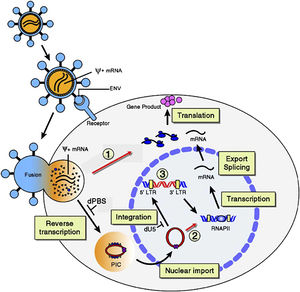Lentiviral Vectors in Gene Therapy
A Viral Biorealm page on the family Lentiviral Vectors in Gene Therapy
Lentiviruses are some of the most recognizable–and life threatening–vertebrate viruses. Viruses in this genus include human immunodeficiency virus (HIV), simian immunodeficiency virus (SIV), and feline immunodeficiency virus (FIV). Their exogenous characteristics make them incredibly ideal for use in gene therapy.
Gene therapy requires delivery vehicles to transfer a gene into an organism's chromosome. Lentiviral vectors are highly successful in permanently changing the target cell and thus increase the efficiency of therapeutic treatment. Hemophilia and other blood-related diseases, AIDS, and various cancers are current targets of lentiviral vectors and they can be used in conjunction with other antiviral and anticancer drugs.
About Lentiviruses
Retroviruses are characterized by their use of the host cell's reverse transcriptase to create DNA from viral RNA. The DNA is then incorporated into the host's DNA genome. Viruses in the genus lentiviruses have slow incubation periods and are categorized into five different serotypes based on their host: primates, sheep/goats, horses, cats, and cattle. RELIK was found to be the first endogenous lentivirus, infecting rabbits, dating millions of years [x]. Present lentiviruses are exogenous, incorporating their DNA into a host's upon infection, and they can infect non-dividing cells.
After a long incubation period and subsequent cell divisions and virus gene proliferation, lentiviruses cause prolonged illness, such as AIDS in humans. Much is known about the method of infection of lentiviruses.

Lentiviral Vectors
Successful gene therapy requires permanent expression of the gene of interest in the target cell. The efficiency of the mode of gene delivery obviously correlates to the success of DNA integration into the host. Lentiviruses have been of interest for many years [x] because of their notoriously successful infection rate
replications cycle
transitional endogenous
evolution?
targeting cell types in vivo and delivery methods
SAFETY METHODS
Current Lentiviral Vectors
Potential Side Effects
Future Directions of Lentiviral Vectors
Various pharmaceutical and research companies focus solely on lentiviral gene therapy
see http://www.lentigen.com/
stem cells
vaccines
T cell therapies
proteins?
References
[1] Katzourakis, A., M. Tristem, O. G. Pybus, R. J. Gifford. 2007. "Discovery and analysis of the first endogenous lentivirus." Proceedings of the NAtional Academy of Sciences of the United States of America. 104: 6261-6265.
[2] Naldini, L. 1998. "Lentiviruses as gene transfer agents for delivery to non-dividing cells." Current Opinion in Biotechnology. 9: 457-463.
Page authored by Irene McIntosh for BIOL 375 Virology, December 2012
